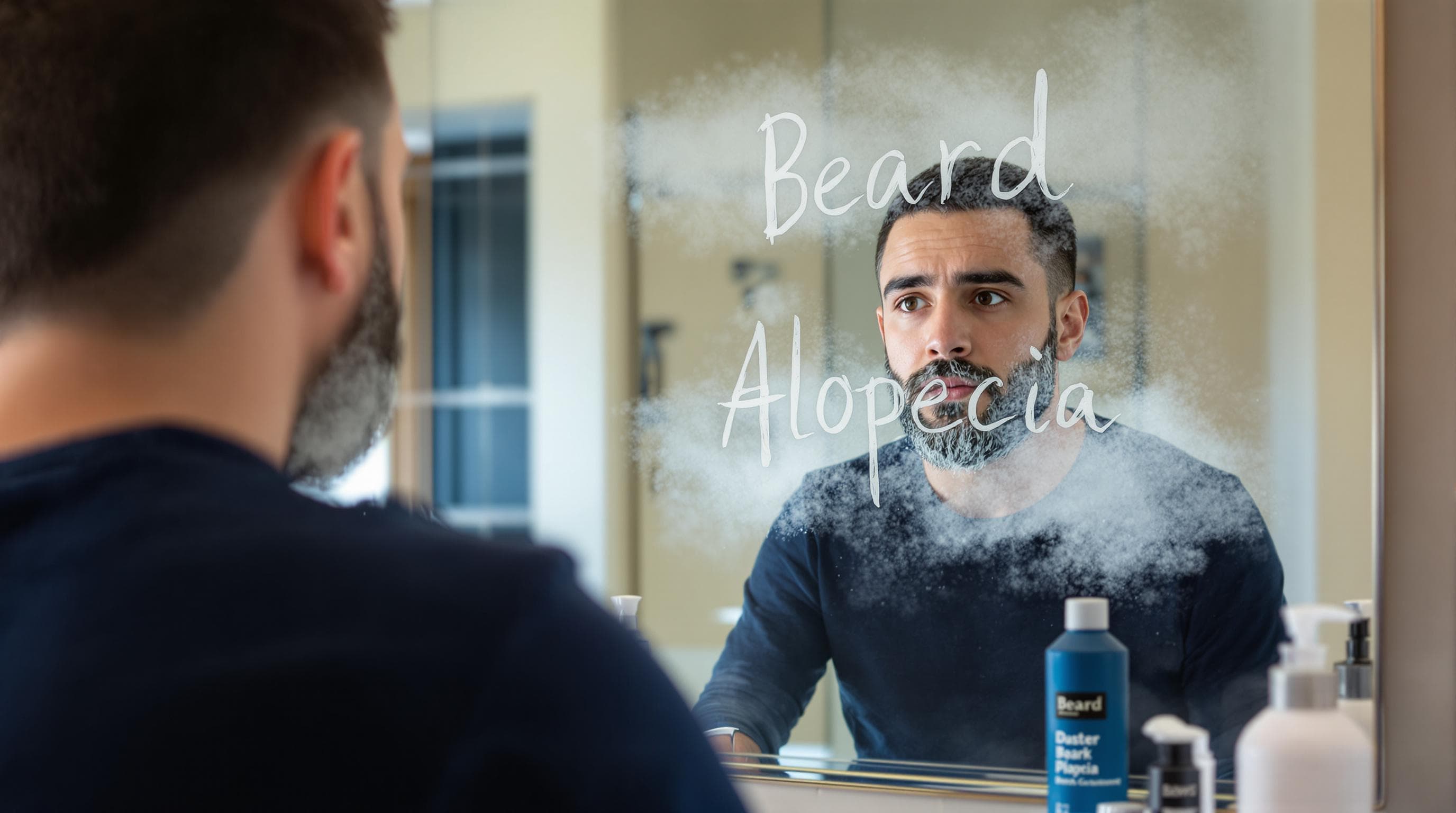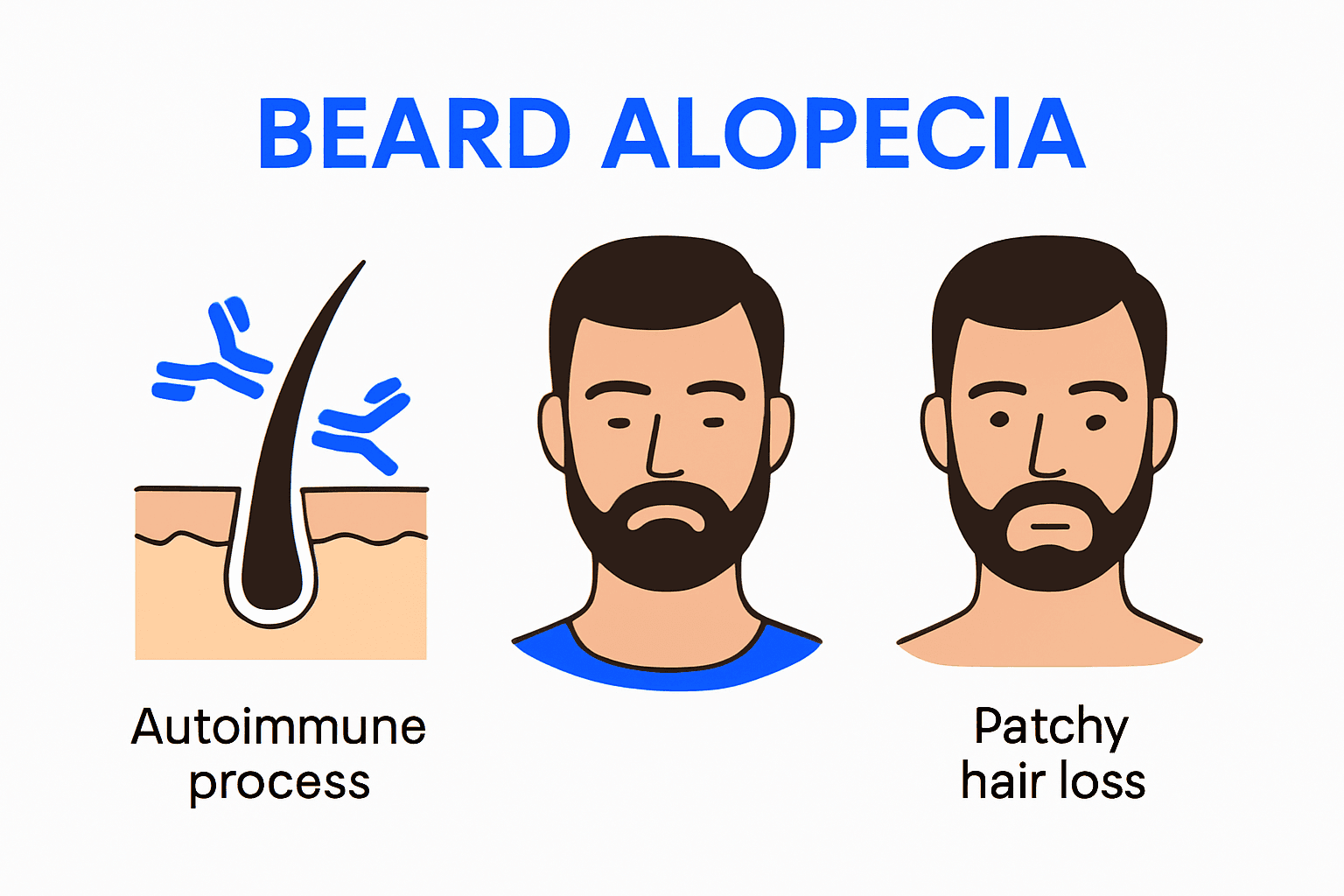Blog
Learning Materials
Beard Alopecia: Causes, Symptoms, and Best Solutions 2025
Updated: July 22, 2025

Beard alopecia can show up out of nowhere and leave you staring at smooth patches instead of your usual facial hair. People often think losing beard hair is rare or comes from poor grooming, but that is not the case. The surprising truth is that over 45% of men with beard alopecia may also see hair loss on their scalp within just 12 months, revealing this issue is more common and complex than most expect.
Table of Contents
- Understanding Beard Alopecia And Its Symptoms
- Key Causes And Risk Factors For Beard Hair Loss
- Effective Treatment Options And Home Care Tips
- Tracking Progress: Personalized Solutions And Expert Advice
Quick Summary
| Takeaway | Explanation |
|---|---|
| Beard alopecia is an autoimmune condition. | The immune system mistakenly attacks hair follicles in the beard area, leading to patchy or complete hair loss. |
| Genetic factors increase risk of beard hair loss. | Individuals with a family history of autoimmune disorders are more likely to develop beard alopecia, indicating a hereditary component. |
| Stress management is essential for treatment. | Chronic stress can disrupt hormonal balance and contribute to hair loss, making stress reduction a key aspect of management. |
| Medical treatments include corticosteroid injections. | Intralesional corticosteroids like triamcinolone acetonide can stimulate hair follicle recovery and promote regrowth. |
| Monitor progress with professional assessments. | Regular dermatological consultations and imaging techniques can help track hair regrowth and treatment effectiveness. |
Understanding Beard Alopecia and Its Symptoms
Beard alopecia represents a complex hair loss condition affecting men's facial hair growth patterns. This specific type of hair loss can manifest unexpectedly, creating distinct challenges for individuals experiencing sudden changes in beard hair density and distribution.
What Is Beard Alopecia?
Beard alopecia is an autoimmune condition where the body's immune system mistakenly attacks hair follicles in the beard region, resulting in patchy or complete hair loss. According to National Institute of Arthritis and Musculoskeletal and Skin Diseases, this disorder can develop rapidly and unpredictably, creating circular or oval patches of hair loss.
The condition differs from typical hair thinning because it produces well-defined areas of complete hair absence. Research published in the Journal of Clinical Medicine indicates that beard alopecia areata (BAA) often presents with distinctive dermoscopic features, including yellow dots, broken hairs, and short vellus hairs.

Identifying Symptoms and Manifestations
Recognizing beard alopecia involves understanding its unique symptom profile. Typical manifestations include:
- Sudden Hair Loss: Rapid development of smooth, circular patches without inflammation or scarring
- Patchy Appearance: Well-circumscribed areas of complete hair absence in the beard region
- Potential Sensory Changes: Some individuals report tingling or mild discomfort before hair loss occurs
To help readers quickly recognize the symptoms and their possible effects, here is a concise summary table:
| Symptom | Description | Psychological Impact |
|---|---|---|
| Sudden Hair Loss | Rapid smooth patches, usually circular or oval | May decrease self-confidence |
| Patchy Appearance | Well-defined areas of no beard hair | Can trigger social anxiety |
| Sensory Changes | Tingling or mild discomfort before hair loss | Adds to emotional distress |
| No Inflammation or Scarring | Hair loss without redness or permanent skin damage | May cause confusion/frustration |
Beyond physical symptoms, beard alopecia can significantly impact psychological well-being. The unexpected hair loss often triggers emotional responses, including reduced self-confidence and social anxiety. Learn more about tracking your hair health progression.
Understanding the underlying mechanisms becomes crucial for effective management. The immune system's aberrant response targets hair follicles, disrupting normal growth cycles. This autoimmune reaction can be associated with other conditions like atopic dermatitis, vitiligo, and psoriasis, suggesting a complex interplay of genetic and environmental factors.
While the exact triggers remain not fully understood, researchers have identified potential contributing elements such as genetic predisposition, stress, and hormonal imbalances. The unpredictable nature of beard alopecia makes it challenging to prevent, but early recognition and professional consultation can help develop targeted treatment strategies.
Medical professionals typically diagnose beard alopecia through comprehensive clinical examination, which may include dermoscopic analysis and sometimes skin biopsy. The goal is not just to assess the current condition but to understand potential underlying health considerations that might be influencing hair loss.
Patients experiencing beard alopecia should approach the condition with patience and seek professional medical advice. While the journey can be emotionally challenging, numerous management and treatment options exist to support individuals through this experience.
Key Causes and Risk Factors for Beard Hair Loss
Beard hair loss is a multifaceted condition influenced by numerous genetic, environmental, and physiological factors. Understanding these underlying causes can help individuals better comprehend their specific hair loss journey and potential management strategies.
Autoimmune and Genetic Triggers
Autoimmune disorders play a significant role in beard hair loss. According to research published in the Journal of Clinical Medicine, beard alopecia areata (BAA) often stems from complex immune system dysfunction. The body mistakenly attacks healthy hair follicles, causing sudden and unpredictable hair loss.
Genetic predisposition emerges as a critical risk factor. The National Institute of Arthritis and Musculoskeletal and Skin Diseases highlights that individuals with a family history of autoimmune conditions have a higher likelihood of developing beard alopecia. This genetic component suggests a hereditary vulnerability to immune system irregularities affecting hair growth.
Environmental and Lifestyle Influences
Multiple external factors contribute to beard hair loss risk. Chronic stress represents a significant trigger, disrupting hormonal balance and immune system functioning. Professional studies indicate that prolonged psychological stress can accelerate hair follicle deterioration and compromise overall hair health.
Additional environmental risk factors include:
- Nutritional Deficiencies: Insufficient protein, iron, and vitamin intake can compromise hair follicle strength
- Hormonal Imbalances: Fluctuations in testosterone and other hormones directly impact beard hair growth
- Chronic Health Conditions: Thyroid disorders, diabetes, and other systemic diseases can trigger hair loss
Learn more about personalized hair health tracking to understand your unique risk profile.
Infectious and Inflammatory Conditions
Certain medical conditions can directly contribute to beard hair loss. A comprehensive medical review identifies multiple potential causes beyond autoimmune responses, including:
- Tinea barbae (fungal infection)
- Pseudofolliculitis barbae (inflammatory skin condition)
- Bacterial or viral infections affecting hair follicles
To clarify the major categories of beard hair loss causes and their examples, here is an organized summary table:
| Category | Examples / Triggers |
|---|---|
| Autoimmune & Genetic Factors | Autoimmune disorders, family history, genetic predisposition |
| Environmental & Lifestyle | Stress, nutritional deficiencies, hormonal imbalances, chronic diseases |
| Infectious & Inflammatory | Tinea barbae, pseudofolliculitis barbae, bacterial/viral infections |
A multicenter study revealed that approximately 45.5% of male patients with beard alopecia developed scalp hair loss within 12 months, underscoring the potential progression and complexity of this condition.
Professional medical consultation remains crucial for accurate diagnosis and targeted treatment. Each individual's beard hair loss experience is unique, influenced by a complex interplay of genetic, environmental, and physiological factors. Understanding these potential causes empowers individuals to seek appropriate medical guidance and explore personalized management strategies.
Effective Treatment Options and Home Care Tips
Managing beard alopecia requires a comprehensive approach that combines medical interventions, lifestyle modifications, and supportive home care strategies. Understanding the most effective treatment options can help individuals navigate their hair loss journey with confidence and hope.
Medical Treatment Approaches
Medical professionals offer several targeted treatments for beard alopecia. Research published in dermatological journals highlights intralesional corticosteroids as a primary intervention. Specifically, triamcinolone acetonide injections can help stimulate hair follicle recovery and reduce immune system attacks.
Topical treatments play a crucial role in management. Minoxidil, a widely recognized hair regrowth medication, shows promising results in promoting beard hair regeneration. Dermatologists may also recommend combination therapies, including:
- Immunomodulatory Medications: Reduce immune system attacks on hair follicles
- Topical Corticosteroids: Minimize inflammation and support hair regrowth
- Platelet-Rich Plasma (PRP) Therapy: Utilize the body's natural healing mechanisms
Explore personalized treatment strategies to understand your unique hair restoration potential.
Natural and Home Care Strategies
Complementing medical treatments, natural approaches can support overall hair health. A systematic review on botanical treatments reveals interesting insights into natural hair care. Rosemary oil, for instance, demonstrates potential in enhancing microcapillary perfusion and supporting hair growth.
Effective home care strategies include:
- Nutritional Support: Consume protein-rich foods and essential vitamins
- Stress Management: Practice relaxation techniques like meditation
- Protective Skincare: Use gentle beard care products and avoid harsh chemicals
The American Academy of Dermatology recommends protecting exposed areas from sun damage. Wearing wide-brimmed hats and using gentle sun protection can prevent additional skin and hair follicle stress.
Psychological Support and Lifestyle Considerations

Beard alopecia extends beyond physical symptoms, impacting emotional well-being. Mental health support becomes an integral part of comprehensive treatment. Support groups, counseling, and stress reduction techniques can help individuals manage the psychological aspects of hair loss.
Lifestyle modifications can significantly influence hair health. Maintaining a balanced diet, getting adequate sleep, and reducing chronic stress contribute to overall immune system regulation. Regular exercise and proper hydration support optimal bodily functions that may indirectly benefit hair follicle health.
It is essential to approach beard alopecia with patience and a holistic perspective. While complete hair restoration may not always be possible, multiple strategies can help manage the condition effectively. Consulting with dermatology specialists ensures personalized treatment plans tailored to individual needs and specific hair loss patterns.
Remember that each individual's experience with beard alopecia is unique. What works for one person may not work identically for another. Persistence, professional guidance, and a comprehensive approach are key to navigating this challenging condition.
Tracking Progress: Personalized Solutions and Expert Advice
Navigating beard alopecia requires a strategic approach that combines professional medical guidance, technological advancements, and personalized tracking methods. Understanding how to monitor and document your hair loss journey can significantly improve treatment outcomes and provide valuable insights into your unique condition.
Professional Monitoring and Diagnostic Techniques
Advanced diagnostic techniques have revolutionized how medical professionals track beard alopecia progression. The National Institute of Arthritis and Musculoskeletal and Skin Diseases highlights that around the edges of hair loss patches, short broken hairs or 'exclamation point' hairs can be critical diagnostic indicators.
Dermatologists employ multiple tracking strategies:
- Dermoscopic Analysis: Detailed microscopic examination of hair follicles
- Photographic Documentation: Regular high-resolution images to track changes
- Blood Work: Comprehensive tests to identify underlying immune system irregularities
Learn about personalized hair health tracking to understand your unique progression patterns.
Treatment Response and Regrowth Monitoring
Understanding treatment effectiveness requires systematic observation. Research indicates that approximately 50% of patients with alopecia areata experience natural hair regrowth within one year without intervention. For those undergoing treatment, specific markers help assess progress.
Key monitoring indicators include:
- Hair Density Measurements: Quantifying hair follicle count and distribution
- Regrowth Pattern Assessment: Tracking new hair emergence and texture
- Treatment Response Timeline: Evaluating changes after interventions like intralesional corticosteroids
Medical studies suggest that intralesional corticosteroid treatments, using triamcinolone acetonide at concentrations of 2.5 to 5 mg/mL, can stimulate new beard hair growth within 6 to 8 weeks.
Emerging Technologies and Personalized Approaches
Cutting-edge technologies are transforming beard alopecia management. Innovative tracking methods now leverage artificial intelligence and advanced imaging techniques to provide more precise, personalized insights. Comprehensive dermatological research highlights emerging treatments like Janus kinase (JAK) inhibitors, which show promising results in restoring facial hair.
Personalized tracking involves:
- Detailed photographic documentation
- Regular dermatological consultations
- Advanced genetic and immunological assessments
- AI-powered hair growth prediction models
Patients should maintain open communication with healthcare providers, documenting changes, potential triggers, and treatment responses. Each individual's beard alopecia journey is unique, requiring a tailored, patient-centered approach.
Remember that progress is not always linear. Some individuals might experience fluctuating hair loss and regrowth patterns. Patience, consistent monitoring, and a holistic approach are crucial in managing beard alopecia effectively. Professional guidance combined with personal commitment can significantly improve treatment outcomes and overall quality of life.
Frequently Asked Questions
What is beard alopecia?
Beard alopecia is an autoimmune condition where the immune system mistakenly attacks hair follicles, resulting in patchy or complete hair loss in the beard area.
What are the main symptoms of beard alopecia?
Symptoms include sudden hair loss in smooth, circular patches, a patchy appearance without inflammation, and potential sensory changes like tingling or mild discomfort.
What causes beard hair loss?
Beard hair loss can be caused by autoimmune dysfunction, genetic predisposition, chronic stress, nutritional deficiencies, and infectious or inflammatory conditions affecting hair follicles.
How can I treat beard alopecia effectively?
Treatment options include intralesional corticosteroid injections, topical treatments like minoxidil, natural strategies such as nutritional support, and psychological support for emotional well-being.
Take Control of Beard Alopecia With AI-Powered Solutions
Are you tired of wondering why beard hair loss happens and feeling frustrated with unpredictable patchy spots or slow regrowth? The journey through beard alopecia is stressful and can deeply affect your confidence. If you want real answers to your unique hair loss patterns, it is time to move beyond one-size-fits-all advice and generic home remedies. With MyHair.ai, you can finally see what is driving your beard alopecia. You get a personalized assessment, progress tracking, and actionable solutions that fit your goals, not just general suggestions.

Imagine uploading a clear scan and getting AI-driven insights tailored to your beard alopecia. Picture how easy it is to track each stage of your recovery or get custom product recommendations designed for your needs. Do not let uncertainty hold you back. Start now by visiting MyHair.ai and discover how your beard and overall hair health can change for the better. Take the first step on your personalized growth path with a quick and private scan upload, then explore everything from in-depth beard hair loss solutions to targeted improvement strategies. Start building your confidence today with insight only AI can deliver.